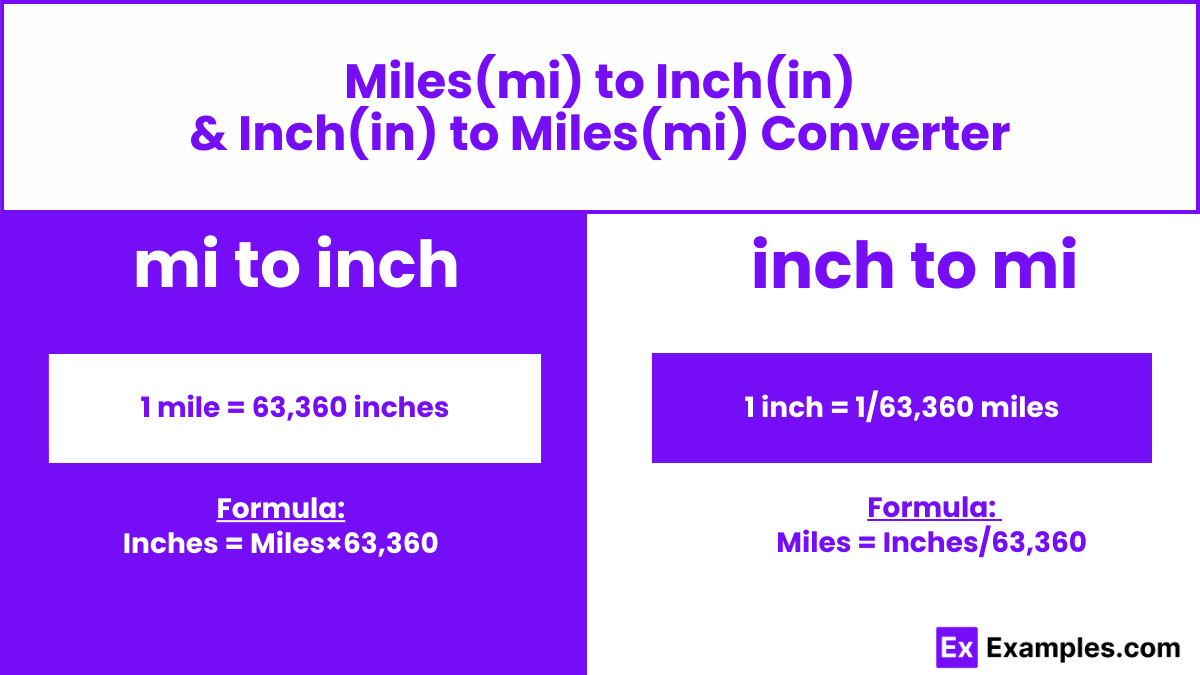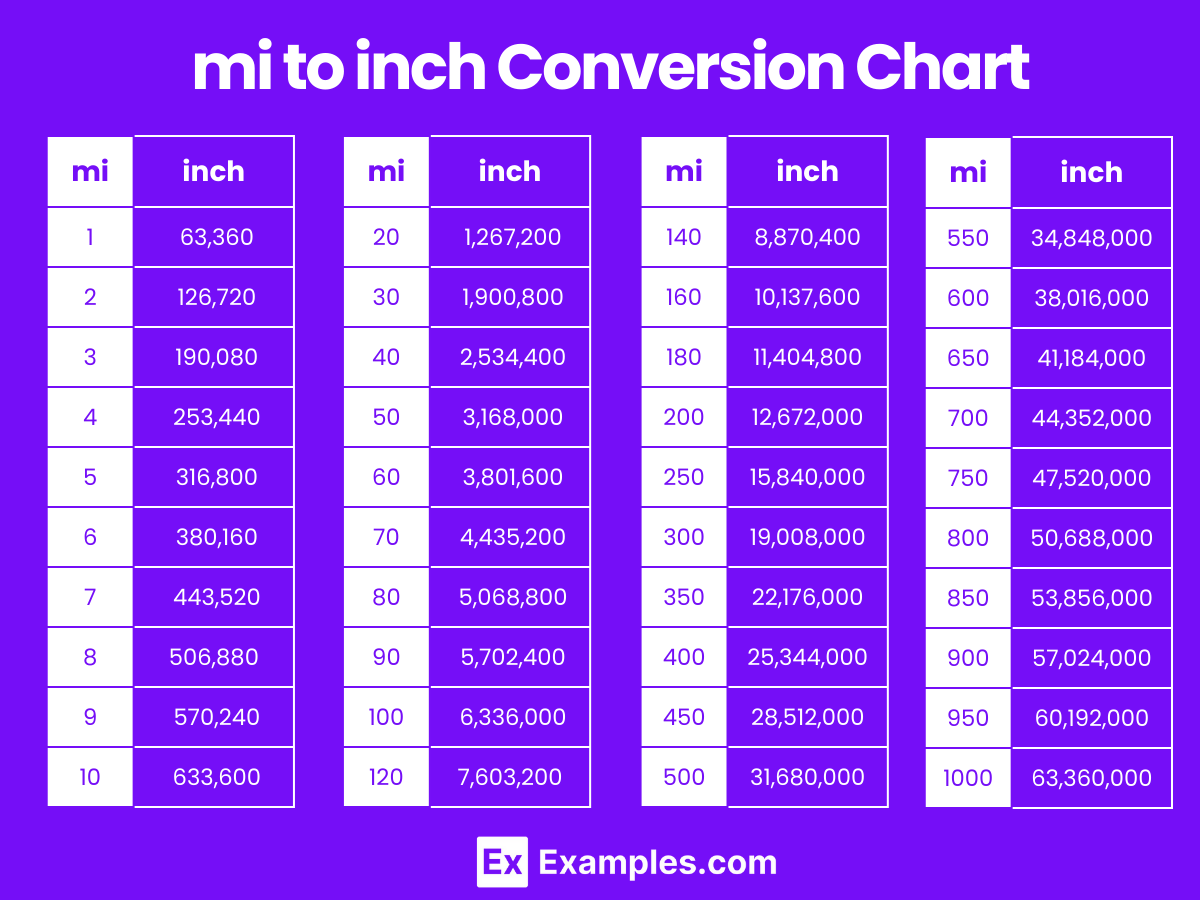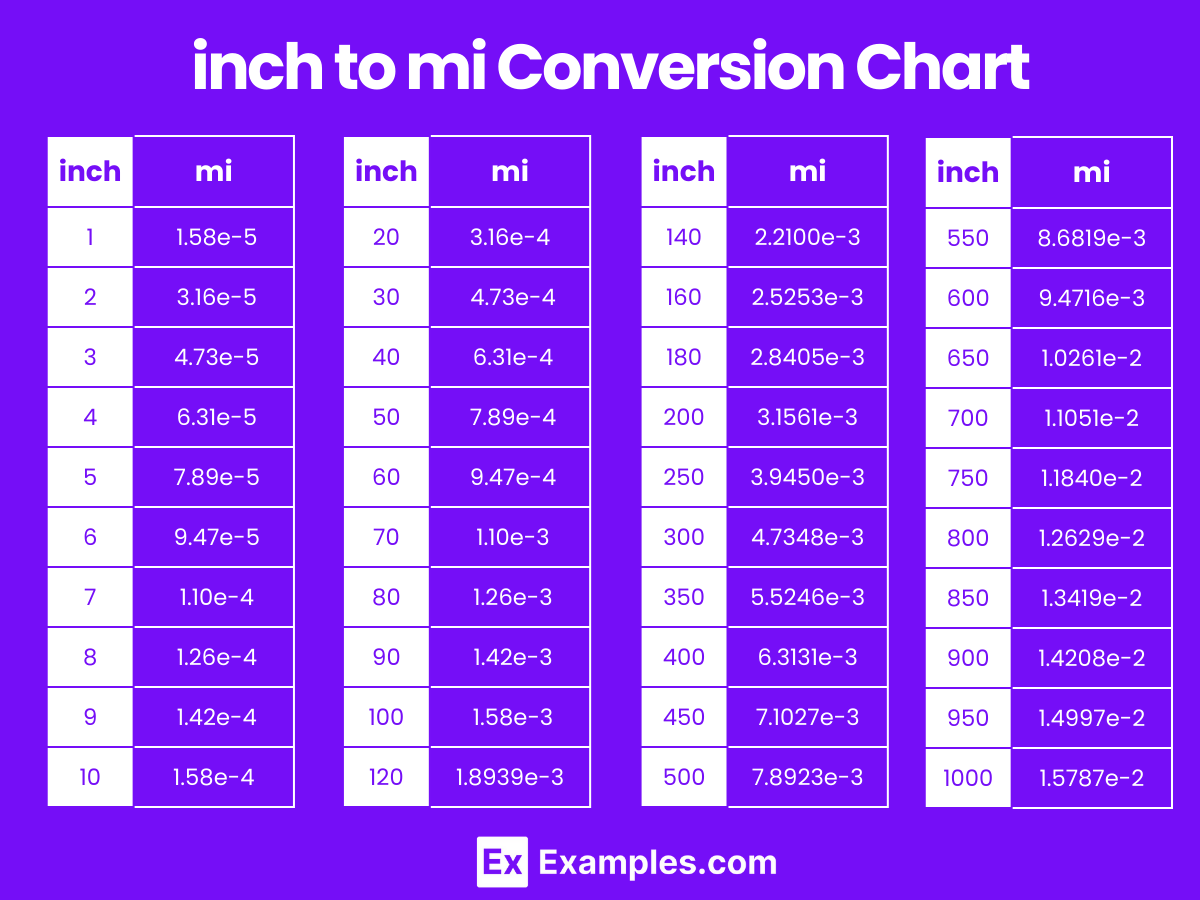Effortlessly convert your length measurements between mile and inches on Examples.com by simply entering the desired values.
mi to inch
Formula: Length in inches (inch) = Length in miles (mi) × 63360
Mile:
Inch:
| Miles | Inches |
|---|---|
| 1 | 63360 |
inch to mi
Formula: Length in miles (mi) = Length in inches (inch) ÷ 63360
Inch :
Mile :
| Inches | Miles |
|---|---|
| 1 | 0.0000157828 |
Length Converters to Mile (mi)
| Yard to Mile | Feet to Mile | Inch to Mile |
| Nautical Mile to Mile | Kilometer to Mile | Meter to Mile |
| Centimeter to Mile | Millimeter to Mile | Micrometer to Mile |
| Nanometer to Mile |
Length Converters to Inch (in)
| Kilometer to Inch | Meter to Inch | Centimeter to Inch |
| Millimeter to Inch | Micrometer to Inch | Nanometer to Inch |
| Mile to Inch | Yard to Inch | Feet to Inch |
| Nautical Mile to Inch |
Conversion Factors:
- Miles to Inches: 1 mile = 63,360 inches (since 1 mile = 5280 feet and 1 foot = 12 inches)
- Inches to Miles: 1 inch = 1/63,360 miles
How to Convert Miles to Inches:
To convert a distance in miles to inches, multiply the number of miles by 63,360.
Inches=Miles×63,360
Example: Convert 2 miles to inches.
Inches=2×63,360=126,720 inches
How to Convert Inches to Miles:
To convert a measurement from inches to miles, divide the number of inches by 63,360.
Miles=Inches/63,360
Example: Convert 50,000 inches to miles.
Miles=50,000/63,360≈0.789 miles

Miles to Inches Conversion Table
| Miles (mi) | Inches (in) |
|---|---|
| 1 mile | 63,360 inches |
| 2 miles | 126,720 inches |
| 3 miles | 190,080 inches |
| 4 miles | 253,440 inches |
| 5 miles | 316,800 inches |
| 6 miles | 380,160 inches |
| 7 miles | 443,520 inches |
| 8 miles | 506,880 inches |
| 9 miles | 570,240 inches |
| 10 miles | 633,600 inches |
| 20 miles | 1,267,200 inches |
| 30 miles | 1,900,800 inches |
| 40 miles | 2,534,400 inches |
| 50 miles | 3,168,000 inches |
| 60 miles | 3,801,600 inches |
| 70 miles | 4,435,200 inches |
| 80 miles | 5,068,800 inches |
| 90 miles | 5,702,400 inches |
| 100 miles | 6,336,000 inches |
mi to inch Conversion Chart

Inches to Miles Conversion Table
| Inches (in) | Miles (mi) [Exponential Notation] |
|---|---|
| 1 inch | 1.58e-5 miles |
| 2 inches | 3.16e-5 miles |
| 3 inches | 4.73e-5 miles |
| 4 inches | 6.31e-5 miles |
| 5 inches | 7.89e-5 miles |
| 6 inches | 9.47e-5 miles |
| 7 inches | 1.10e-4 miles |
| 8 inches | 1.26e-4 miles |
| 9 inches | 1.42e-4 miles |
| 10 inches | 1.58e-4 miles |
| 20 inches | 3.16e-4 miles |
| 30 inches | 4.73e-4 miles |
| 40 inches | 6.31e-4 miles |
| 50 inches | 7.89e-4 miles |
| 60 inches | 9.47e-4 miles |
| 70 inches | 1.10e-3 miles |
| 80 inches | 1.26e-3 miles |
| 90 inches | 1.42e-3 miles |
| 100 inches | 1.58e-3 miles |
inch to mi Conversion Chart
Difference Between Miles to Inches
| Feature | Miles | Inches |
|---|---|---|
| Definition | A mile is a unit of length primarily used in the United States and the United Kingdom, equal to 5280 feet. | An inch is a small unit of length equal to 1/12 of a foot. |
| Length | One mile is significantly longer than an inch, specifically 63,360 inches per mile. | One inch is just a very small fraction of a mile, precisely 0.0000157828 miles (or 1/63,360 of a mile). |
| Usage Contexts | Miles are commonly used for measuring larger distances, such as in travel or large-scale mapping. | Inches are typically used in smaller-scale measurements such as in carpentry, sewing, and for measuring height or smaller objects. |
| Conversion Factor | To convert miles to inches, multiply by 63,360. | To convert inches to miles, divide by 63,360. |
| Typical Application | Used in contexts like driving distances between cities or measuring distances on maps. | Used for detailed measurements in construction, manufacturing, and home projects. |
| Scale | Macroscopic scale, suitable for use in geography and widespread area measurements. | Microscopic scale, ideal for detailed and precision work in various crafts and industries. |
| Example | The distance between New York and Boston is about 200 miles. | The length of a standard pencil is approximately 7 inches. |
1. Solved Examples on Converting Miles to Inches
Example 1: Convert 1 mile to inches
Inches=1 mile×63,360 in/mile
Inches=63,360 inches
Result: 1 mile is equal to 63,360 inches.
Example 2: Convert 3 miles to inches
Inches=3 miles×63,360 in/mile
Inches=190,080 inches
Result: 3 miles are equal to 190,080 inches.
Example 3: Convert 0.5 miles to inches
Inches=0.5 miles×63,360 in/mile
Inches=31,680 inches
Result: 0.5 mile is equal to 31,680 inches.
Example 4: Convert 2.25 miles to inches
Inches=2.25 miles×63,360 in/mile
Inches=142,560 inches
Result: 2.25 miles are equal to 142,560 inches.
Example 5: Convert 5 miles to inches
Inches=5 miles×63,360 in/mile
Inches=316,800 inches
Result: 5 miles are equal to 316,800 inches
2. Solved Examples on Converting Inches to Miles
Example 1: Convert 63,360 inches to miles
Miles=63,360 inches/63,360 in/mile
Miles=1 mile
Result: 63,360 inches is equal to 1 mile.
Example 2: Convert 31,680 inches to miles
Miles=31,680 inches/63,360 in/mile
Miles=0.5 miles
Result: 31,680 inches is equal to 0.5 miles.
Example 3: Convert 158,400 inches to miles
Miles=158,400 inches/63,360 in/mile
Miles=2.5 miles
Result: 158,400 inches is equal to 2.5 miles.
Example 4: Convert 1,000 inches to miles
Miles=1,000 inches/63,360 in/mile
Miles=0.01578 miles
Result: 1,000 inches is approximately 0.01578 miles.
Example 5: Convert 316,800 inches to miles
Miles=316,800 inches/63,360 in/mile
Miles=5 miles
Result: 316,800 inches is equal to 5 miles.
1. Why do we multiply by 63,360 to convert miles to inches?
Because one mile equals 5280 feet, and one foot equals 12 inches, multiplying these gives 63,360 inches per mile.
2. How can I use this conversion in everyday life?
This conversion can be used for high-level estimation in tasks such as property layout planning or travel distance visualization.
3. Why might an engineer need to convert inches to miles?
Engineers might need this conversion for projects involving large-scale mapping or surveying where distances are initially measured in inches for precision.
4. How accurate is the conversion from miles to inches?
The conversion is mathematically exact since it is based on the defined lengths of a mile and an inch.
5. Can I convert road distances from inches to miles for a long trip?
Yes, converting such distances to miles can give a better sense of scale and help in planning fuel stops and rest periods.
6. How does converting inches to miles help in education?
It helps students understand large scale dimensions and practice mathematical operations involving division and large numbers.
7. Can this conversion be useful in sports?
Yes, converting athletic track lengths from miles to inches can help in setting precise training goals and understanding track dimensions better.


